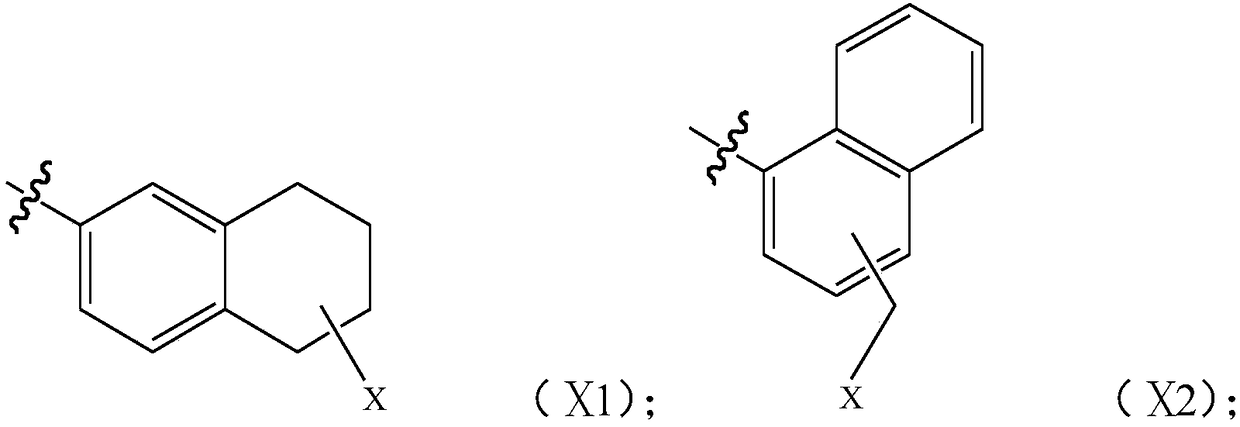Gastrodin derivatives, their preparation methods, their applications and pharmaceutical preparations
A pharmaceutical preparation, gastrodin technology, applied in the field of gastrodin, to achieve obvious anticoagulant effect
- Summary
- Abstract
- Description
- Claims
- Application Information
AI Technical Summary
Problems solved by technology
Method used
Image
Examples
preparation example Construction
[0045] The present invention also provides a preparation method of gastrodin derivatives, comprising:
[0046] Under the action of a catalyst, the compound having the structure of formula (XI) is reacted with the compound having the structure of formula (XII) in a solvent to obtain a gastrodin derivative having the structure of formula (II);
[0047]
[0048] R-OH (Ⅻ);
[0049]
[0050] Wherein, R is a substituted naphthalene ring.
[0051] In the process of preparing gastrodin derivatives, the compound of formula (XI) is tetraacetylglucose trichloroacetimidate, which can be prepared according to the preparation methods well known to those skilled in the art, and this application has no special limits. The molar ratio of the tetraacetylglucose trichloroacetimidate to the compound having the structure of formula (XII) is preferably 2 to 3:1, the reaction temperature is preferably 20 to 30°C, and the reaction time is Preferably it is 1-3h. The reaction process of gastr...
Embodiment 1
[0066] Embodiment 1: Preparation of KPC-4000012
[0067]
[0068] Add compound 1 (492.7mg, 1.23mmol, 2.0eq) in a single-necked flask of 25ml, compound 2 (162.2mg, 0.62mmol, 1.0eq) and molecular sieve (2.0g, 4A), adopt the vacuum oil pump to remove the reaction device inside The air was replaced with nitrogen, dichloromethane (4.0ml) was added to the flask, the device was placed in an ice bath, stirred for 10 minutes, and boron trifluoride diethyl ether (83.7mml, 0.68mmol, 1.1eq ), continue to stir for 10 minutes after the dropwise addition, remove the ice bath, allow the reaction solution to naturally warm up to room temperature (20°C), and use TLC to detect the reaction process until the raw materials disappear (2 hours); slowly pour the reaction solution into a container Quench in a beaker with a saturated solution of sodium bicarbonate (20ml), extract the aqueous phase of the mixed solution with dichloromethane (20ml×3), combine the organic phases, wash with water (20ml)...
Embodiment 2
[0070] Embodiment 2: Preparation of KPC-4000013
[0071]
[0072] Add compound 3 (100.0mg, 0.20mmol, 1.0eq) and anhydrous methanol (1.0ml) to a 25ml one-necked flask, place the device in an ice bath, stir for 10 minutes, and add sodium borohydride (7.7mg , 0.20mmol, 1.0eq), continue to stir for 10 minutes, remove the ice bath, allow the reaction solution to naturally warm up to room temperature (20 ° C), monitor the reaction process with TLC, until the raw material point disappears (1 minute), spin on a rotary evaporator Remove the solvent from methanol, pour into sodium hydroxide solution (1mol / L, 20ml), extract with ethyl acetate (20ml×3), combine the organic phases, wash the organic phase with water (20ml), and saturated sodium chloride (20ml) Wash the organic phase, dry with anhydrous sodium sulfate, filter the mixture, remove the solvent on a rotary evaporator, and purify the crude product with a silica gel column, eluent ratio: ethyl acetate / petroleum ether=40%, to ob...
PUM
 Login to View More
Login to View More Abstract
Description
Claims
Application Information
 Login to View More
Login to View More - R&D
- Intellectual Property
- Life Sciences
- Materials
- Tech Scout
- Unparalleled Data Quality
- Higher Quality Content
- 60% Fewer Hallucinations
Browse by: Latest US Patents, China's latest patents, Technical Efficacy Thesaurus, Application Domain, Technology Topic, Popular Technical Reports.
© 2025 PatSnap. All rights reserved.Legal|Privacy policy|Modern Slavery Act Transparency Statement|Sitemap|About US| Contact US: help@patsnap.com



